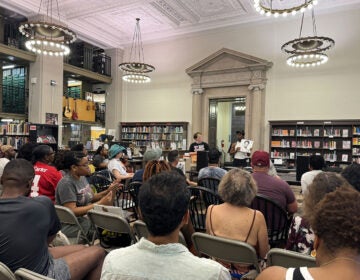Art program helps Alzheimer’s patients focus

Many museums have created programs to make their exhibitions accessible to people in wheelchairs or the blind. The Berman Museum of Art at Ursinus College, in Collegeville, Pa., is reaching out to people with mental disabilities.
When curators set about to select paintings from their collection for their new exhibition called “Access-Ability,” they sought the advice of elderly people at Parkhouse, a nearby nursing facility.
“Who would paint something like that, that has nothing to with anything in the whole world, and then put a tulip in there?” said resident Sarah Stercula, looking at a laminated print of a bluish abstract painting of flowers.
“But the tulip, honey, is sitting with other flowers,” said fellow resident Fran Dubon, a retired high school art teacher.
“Yeah, but they don’t look like flowers to me,” Stercula retorted. “If I saw that, I’d say it’s just a bunch of junk.”
Both Stercula and Dubon have dementia, and require close nursing supervision. But during this argument, their opinions seem perfectly lucid, even if Dubon believes Francoise Gilot’s “Tulips” (1991) was painted in the early 1970s.
“That’s definitely from that period,” said Dubon, pounding the table. “All her friends thought it was beautiful.”
“Her friends thought it was beautiful?” asked Stercula in disbelief.
“When it was painted, oh sure. Because it’s the period she’s used to seeing,” said Dubon, looking askance at Stercula. “You’re not fond of this style, I think.”
And then they all laughed. Laughing is an unusual reaction for many Alzheimer’s patients and people with dementia.
“In a normal setting, they are more anxious, tearful, not knowing what’s going on,” said Sally Hawk-Jones, activity director at Parkhouse. “You don’t perceive your environment in a way that’s going to keep you calm. It’s easy to get afraid and upset.”
But in this quite room, four elderly women in different stages of dementia have been looking at art and talking about it for more than an hour. “That’s unheard of,” said Hawk-Jones.
People with Alzheimer’s have degenerating brains, but certain parts of the brain could be functioning perfectly well. The curators and directors of the Berman Museum are using art to stimulate those normal parts of the brain. Berman is the only museum in this region associated with ARTZ: Artists for Alzheimer’s, an organization that trains museums on how to engage with people who have dementia.
Parkhouse has a long history of busing its residents to the Berman for outings, and now it’s partnering with the museum to develop programs that engage residents whose minds are slipping. Several times this year, Berman staff arrived at the Parkhouse with an armload of laminated prints of images in the collection. In small groups, in quiet rooms (a calm setting is crucial), staff and residents go through each image and talk about feelings and memories they conjure.
The Berman’s director of education, art historian Susan Shifrin, has to reign in her academic training in these situations.
“If we get into a conversation about whether residents like sandwiches as a result of looking at a “Sandwich and Soda,” by [Roy] Lichtenstein, then our goal is met,” said Shifrin. “We talk about the art, but we’re focused on having an exchange, having their voices heard and validated, and they are interrelated.”
Regardless of an artist’s intention or historical context, here the art is used to trigger dormant memories and emotional reactions, brain functions which Alzheimer’s can leave intact.
“That’s another way of tapping into who these people are, in their real lives,” said Shifrin, whose own mother has Alzheime’rs. “I’m not sure every art historian is cut out to do this, but for me it’s the most meaningful thing I’ve done.”
It doesn’t matter if Fran Dubon believes “Tulips” was painted in the 1970s or that Sarah Stercula hates images of abstract flowers — on this particular morning, they were focused and articulate.
“I like to go places where I can sit and hear people talk,” said Stercula “I can’t say I take it all home with me, ’cause I don’t. My brain isn’t …” Stercula chuckles and gestures to her head.
“But I love just knowing that I might hear somethng that I can put in my book when I get home. I know what I’m doing, and maybe someday I’ll be able to do a lot more of it.”
In October, Sarah, Fran and the other residents will take a day trip to the Breman, to see the real paintings up close. “Access-Ability” will be on display until Dec. 2.
WHYY is your source for fact-based, in-depth journalism and information. As a nonprofit organization, we rely on financial support from readers like you. Please give today.




